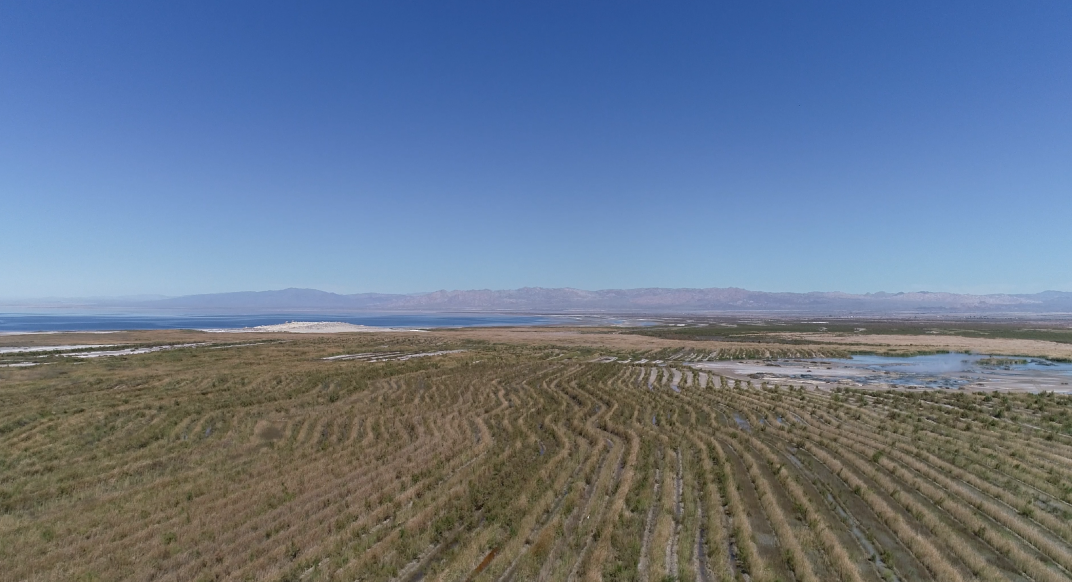
In the ongoing saga that is the Colorado River, the Salton Sea has certainly found its place as an important piece of the river’s story. The sea, an approximately 365-square mile inland lake, crosses two counties, Imperial and Riverside, is home to small communities in both counties (Salton City, Bombay Beach, Desert Shores and Mecca), and to an important California tribe, the Torres Martinez Desert Cahuilla. The Salton Sea basin has been filled over thousands of years, forming massive lakes, when the Colorado River has spilled into the region, only to dry up over time. In its current form, the sea was created in 1905 when manmade canals broke, flooding the basin for two years. Today, the Salton Sea is sustained largely by agricultural run-off flowing from the Imperial Valley, and because it is an inland lake and has no outlet, the sea is faced with a myriad of ecological issues. The sea is also a shrinking body of water. Most would point to water transfers as the reason for it, though Mexico’s reclaiming of New River water, changing agricultural practices (unrelated to transfers) that utilize less water, and climate change might have more to do with the sea’s declining size. The point of this blog is not to debate the causes, but to address recent questions this writer has received about the sea: what’s occurring there now and how the sea fits into the river’s future.
One recurring question of late is why the Species Conservation Habitat (SCH) project, the state’s leading proof-of concept project that calls for building fishponds to both cover playa and maintain a food source for migratory birds, is not yet operating even though the project has been completed. The answer to that question was provided during a recent State Water Resources Control Board workshop to review the California Natural Resources Agency’s (CNRA) annual progress report on its phased approach to restoration—the Salton Sea Management Program. During the workshop, CNRA reported that while work on the initial 4,000 acres of fishponds that make up the SCH has been completed, an expansion of the project is already underway with federal Inflation Reduction Act funding. With the support of that new funding, the SCH is expected to double in size to 8,000 acres. However, to carry out that new construction, CNRA cannot fill the existing fishponds (except for about 170 acres, which have been inundated with water). Ultimately, this is good news and represents a sign of what can be accomplished through local, state and federal partnerships at the sea.
Another recent question was about the status of the sea’s long-term restoration effort. Those who follow the sea’s issues will recall that CNRA is responsible for carrying out near-term projects through 2028, as provided in the Phase 1: 10-Year Plan. At the same time, CNRA was tasked with developing a long-term plan. That plan was developed, though it discussed several alternatives rather than focusing on one path forward. The most important update in terms of long-term restoration is that a new state/federal partnership involving the Army Corps of Engineers has led to the launch of a new feasibility study (informed by CNRA’s plan) that will become the basis for the sea’s long-term restoration. What’s positive about that is that the study will incorporate a cost-sharing concept for restoration that includes 65 percent in federal matching funds to help support restoration. While time will tell what specific direction long-term restoration takes, it is clear that the federal government is taking a stronger interest in the sea and recognizing it is a part of the Colorado River Basin.
What does all of this mean for the sea’s future? That is a difficult question to answer, and it is understandable if there is some sense of uncertainty about what the sea will be in the future. That said, as talks continue on how to manage the Colorado River going forward and developing a new set of guidelines that will manage the river post-2026, the sea will certainly be a part of those discussions. The San Diego County Water Authority continues to deliver a message together with the Imperial Irrigation District and other California parties that the Salton Sea must be considered in those long-term discussions.
In the meantime, work is continuing at the sea, and the groundwork that has occurred in recent years is now bearing results as cooperation, partnerships, and complementary projects all come together to ensure the sea has a future. The vision of that future is still be in development, and questions about available water will take time to address. Stakeholders have a right to be concerned until that vision is set, but there is every reason to be positive and hopeful. Stay tuned for more to come.